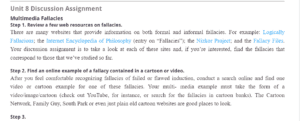Multimedia Fallacies
A fallacy is a deceptive argument or false reasoning. Subsequently, there are various types of fallacies: logical fallacies, informal fallacies, and formal fallacies. A formal fallacy is detected by analyzing the logical form of an argument or reasoning, while an informal fallacy is false reasoning that normal logic cannot detect. A logical fallacy is also defined as an error in reasoning that occurs frequently. Fallacies are grouped into various categories, such as deductive or inductive standards. Therefore, various fallacies are based on these categories: Ad Hominem, Red Herring Fallacy, Appeal to Pity, Affirming the Consequent, and Accent (Staff, 2021). Do you need urgent assignment help ? Get in touch with us at eminencepapers.com. We offer assignment help with high professionalism.
For this discussion, I chose a scene from Family Guy from this link that depicts fallacies, specifically, the Red Herring Fallacy. The Red Herring Fallacy is created when distractions establish an error from an ongoing argument with statements that appear relevant but aren’t. This type of fallacy distracts individuals from the discussed topic (“Fallacies | Internet Encyclopedia of Philosophy,” 2021).
The fallacy is created during a mayoral election debate in the selected piece. Luis Griffin and Mayor West are the two people running for the seat; how they answer citizens’ questions illustrates the Red Herring Fallacy. At the beginning of the clip, a citizen asks Mayor West about the possibility of increasing garbage collection; the Mayor answers the question without answering the question asked, which other citizens find satisfying. The Mayor rambles on about the importance of questions, distracting the audience from the said question. The running mate, Luis Griffin, picks up on this tactic and employs it when asked about the potential to decrease crime in their city, whereby she talks about 9/11 and Jesus Christ. The result is chanting citizens who are impressed by their answers.
This example is an excellent example of the Red Herring Fallacy whereby the running mates give answers related to the questions asked, but they do not answer the question itself, distracting the citizens, and their answers please the citizens. To conclude, fallacies are present in many situations but can be overlooked.
References
Fallacies | Internet Encyclopedia of Philosophy. Iep.utm.edu. (2021). Retrieved 14 April 2021, from https://iep.utm.edu/fallacy/.
Staff, T. (2021). 15 Logical Fallacies You Should Know Before Getting Into a Debate. TheBestSchools.org. Retrieved 14 April 2021, from https://thebestschools.org/magazine/15-logical-fallacies-know/.
Family Guy. Youtube.com. (2020). Retrieved 14 April 2021, from https://www.youtube.com/watch?v=f_ttbfTGs48.
ORDER A PLAGIARISM-FREE PAPER HERE
We’ll write everything from scratch
Question
Unit 8 Discussion Assignment
Multimedia Fallacies
Step 1. Review a few web resources on fallacies.

Multimedia Fallacies
There are many websites that provide information on both formal and informal fallacies. For example: Logically Fallacious; the Internet Encyclopedia of Philosophy (entry on “Fallacies”); the Nizkor Project; and the Fallacy Files. Your discussion assignment is to take a look at each of these sites and, if you’re interested, find the fallacies that correspond to those that we’ve studied so far.
Step 2. Find an online example of a fallacy contained in a cartoon or video.
After you feel comfortable recognizing fallacies of failed or flawed induction, conduct a search online and find one video or cartoon example for one of these fallacies. Your multi- media example must take the form of a video/image/cartoon (check out YouTube, for instance, or search for the fallacies in cartoon banks). The Cartoon Network, Family Guy, South Park or even just plain old cartoon websites are good places to look.
Step 3.
Once you’ve located the example, reconstruct the fallacy from the video or cartoon. You can refer back to the Logically Fallacious site, which we used in Unit 7 discussion to find additional examples and logical forms for your fallacies. Embed the multi-media example on the Discussion Forum (or you can paste in the link), and include your reconstruction and analysis. Be sure to address the following:
- Clearly state the fallacy your example
- Share your reconstructed fallacy and make sure to present the full argument (that the video, image or cartoon suggests) by identifying its implicit premise(s) and
- Explain why you think this is a good example of the
Step 4.
Read and respond to other students’ posts with substantial comments that answer these questions:
- Do you think their reconstruction of the fallacy is well done? If not, how would you reconstruct it?
- Do you think their multi-media represents the fallacy they claimed? If not, what fallacy do you think it represents?
- What variations on their fallacy have you encountered, if any? Or have you seen their multi-media example somewhere before and were you aware that it represented a fallacy?
- Do you have any questions for them regarding the content of their multi-media or about the process of identifying the fallacy?

